Built Cultural Heritage. Perceptions, Attitudes and Opinions Met among the Population of Dâmbovita County (Romania)
Abstract
Preservation and protection of cultural sights represent nowadays an important issue within human communities, especially because they are interesting in terms of using tourism for local development. In this context, one may state that between the local community and the heritage sights there is a special relationship which highlights the connection between present and past and generates values such as identity, traditions, belongingness, social cohesion, etc. Approaching the issues of cultural heritage built among the population of a community surfaces a series of perceptions, attitudes as well as opinions of the inhabitants in relation to them.
Keywords: Built cultural heritageperceptionsattitudesopinionspopulationDâmboviţa County
Introduction
Throughout history the term of cultural heritage has seen a series of definitions and interpretations.
The (material) cultural heritage represents a sub-domain of the national cultural heritage and is
represented by a diversity of historic monuments, ensembles and archaeological sites.
Law no. 422/2001 regarding protection of historic monuments, as republished, defines historic
monuments as “intangible assets, buildings and land located on the territory of Romania, significant for
the national and universal history, culture and civilisation” (Official Monitor of Romania, no. 573 of
July 3, 2006).Law no. 5/2000 (Official Monitor of Romania, no. 152 of April 12, 2000) regarding
approval of National Land Development Plan – Section III (INCFC, 2013), protected areas, includes
another typology which proves to be extremely useful for a pragmatic approach of the domain, i.e.:
1. Monuments and architectural ensembles including: fortresses, ruined royal court ensembles,
fortified churches – citadels; castles, manors, palaces; towers; urban civil buildings; urban ensembles;
wooden churches; ethnographic open-air museums; cave churches; churches and monastery ensembles;
industrial architecture; development of communication means; country architecture monuments
(village residences); rural traditional ensembles.
2. Monuments and archaeological sites: Palaeolithic complexes; Neolithic and Eneolithic
habitations; habitations and necropoles of the Bronze Age; fortifications and habitations of early Iron
Age (hallstattian); Dacian fortifications; ancient cities; buildings; medieval monuments identified
through archaeological research; archaeological reservations comprising sites with settlement levels for
long periods – habitations and necropoles.
In Dâmboviţa County there are at present 1239 historic monuments, categorised as follows: 456
archaeological sites and habitations, 698 architectural monuments, 12 monuments of public nature and
73 funeral monuments.
In this context, Dâmboviţa County is interesting for a series of domains of cultural and historic
interest, firstly for the Museum Complex of the Royal Court in Târgovişte, main site of built heritage of
the county and essential elements in the local identity. In addition, there are ten other museums in the
city, among which: the History Museum, the Museum of Printing and Romanian Book, the
Archaeology Museum, the Museum of Târgovişte’s Writers etc.
Furthermore, the county is of notable interest for the Brâncoveanu Palace Complex in Potlogi
(1698), the Brâncoveneanu Court in Doiceşti (1702), the Ruins of the Feudal Court of Corbeni (Corbii
Mari), the Feudal Fortress of Voineşti; ancient religious habitations inside the county of a significant
heritage value, among which a series of monasteries and hermitages such as Stelea Monastery (XVIth
century), Dealu Monastery (XVth century), Viforâta Monastery (XVth century), Bunea Hermitage
(Vulcana Băi, XVIIth century); wooden churches in Cobia, Cândeşti, Valea Mare, Drăgăeşti, Văleni-
Dâmboviţa etc.
Research methodology
population in which a sight/a place is deemed important from a cultural point of view. This fact implies
protecting and preserving it due to the impact that both natural and human factors may have on
conveying it and for future generations globally.
- knowing and recognising the importance of cultural heritage sights in Dâmboviţa County;
- using such sights in support of the identity of the local community for social cohesion, economic
development, communication between generations;
- stimulating the population’s involvement in protecting and promoting them, obtaining some data
and information with regards to the role and the historic, cultural and social importance attached to
cultural sights;
- capitalizing the built heritage in terms of tourism, as factor of a better quality life through
sustainable regional development based on local values.
literature, questionnaire-based survey, statistical and mathematical data processing, comparative
analysis, graphic representation analysis.
The questionnaire-based method aimed to obtain information concerning opinions, perceptions and
attitudes of respondents with regards to build cultural heritage in Dâmboviţa County.
Therefore, the questionnaire has been applied on a sample of 300 people in the county, 150 in urban
areas and 150 in rural areas, of ages between 18 and 60.
Results and discussions
The main topics analysed have considered the definitions used by the local population when
referring to national cultural heritage, types of buildings classified as belonging to cultural heritage,
importance attached by people to heritage sights, knowing and visiting these sights, assessing them as
the most important or endangered sights, visiting behaviour, participative budgeting, social
responsibility and civic involvement in preservation or rehabilitation activities (National Institute for
Research and Cultural Training, 2015). The first and the second question addressed to respondents
aimed to identify a simple definition given to build cultural heritage, as well as an individual opinion
on what type of buildings/ constructions belong to this type of heritage.
The population’s responses firstly refer to buildings and architectural ensembles such as fortresses,
castles/palaces, religious habitations and monuments, memorial houses, art monuments and objects,
archaeological sites etc. - fig. 1.
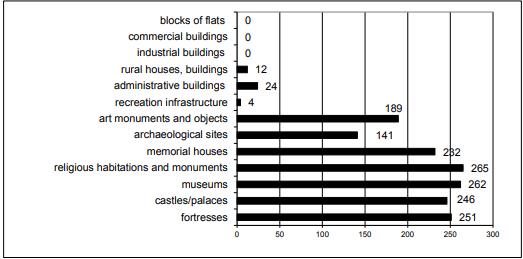
From the point of view of ordinary people, these categories of buildings which are included in the definition of built cultural heritage are very close to the taxonomy used by experts in this field. One should see that most respondents stated the historic, cultural importance as well as their ancientness and the role played by these buildings in the development of the local tourism and not only. The following questions, which refer to the main elements of protection and preservation of cultural heritage buildings on the one hand, mainly capitalise the importance of the identity and the relation to history (for the municipality of Târgovişte or for other localities of Dâmboviţa County such as Potlogi, Băleni, Crânguri, Cobia, Gura Foii, Butimanu, Cândeşti parishes etc.) – fig. 2 and 3.
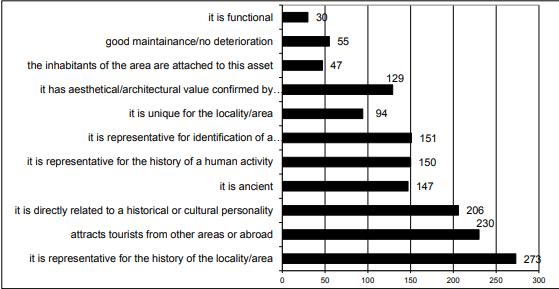
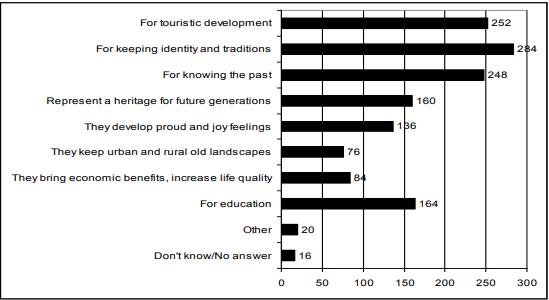
On the other hand, the most significant benefits brought by cultural sights to local communities were the ones in which the respondents identify the representativeness of such sights for the preservation of identity and traditions (95%), development of tourism (84%), knowing the past (82.6%) as well as development of the feeling of pride and joy and their transmission to future generations. More than half of the people questioned (54.6%) also indicate how important it is to know such sights for the education in general and for culture in particular. The economic benefits and the life quality benefits are discerned by the population questioned in a lower percentage, which should represent a sign for the local public authorities with a view to initiate some awareness raising campaigns so that people may understand their advantages in relation to local development.
The fourth question aimed to identify the extent to which the local heritage sights are known and how the local community interacts with them. In case of non-interaction, attention was paid to identification of causes generating such ignorance of local cultural heritage. In all 300 questionnaires applied, at least ten examples of sights were found, being mainly mentioned the Museum Complex of the Royal Court and the most representative museums in Târgovişte, then Dealu, Viforâta and Nucet monasteries, located in the proximity of the city, whereas for the county and in line with the place of origin of the respondents, mentions were mainly made of the Potlogi Palace, wooden churches etc. Responses of more than 50% of respondents were impressive as in most part, the important buildings of their residence areas are known and appreciated, as well as the representative ones in the county, e.g. museums and religious habitations which they visited.
The following questions focused on the analysis of how often they visit the heritage sights, as part of their tourist behaviour. Analysis was made of the frequency of visiting such heritage sights, the manner of collecting information prior to such visits and the context in which such heritage sights are visited (fig. 4-6).
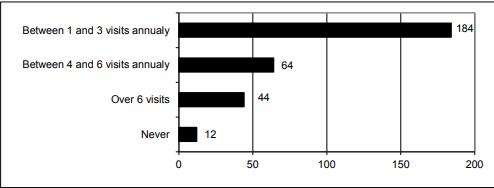
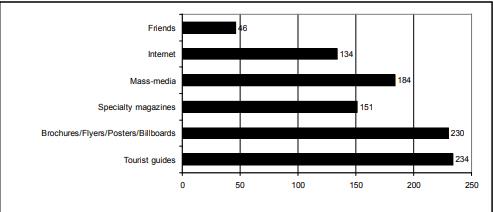
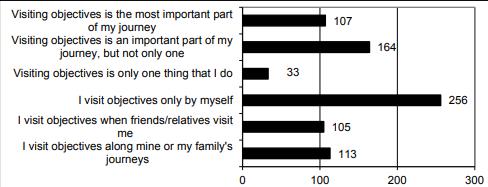
According to results obtained concerning heritage sight-seeing, 184 responses (61.3%) were identified as indicating 2 or 3 visits every year. For most respondents who visit heritage sights when they travel, this is an activity which they carry out alone (85.3%); however, the sight-seeing is an important part of the trip, not the only one. Higher percentages are recorded for respondents from the urban areas compared to those from rural areas. It is likely that such type of tourism combining leisure activities related to natural resources and spending time in the open air of the one hand and visiting cultural sights of the other is defining for most population. Moreover and also in terms of visiting context, most respondents tend to visit heritage sights and/or with their entourage of close friends during the trip more than when their friends or relatives visit them. In other words, one may say that hospitality includes heritage sight-seeing only in very few cases, the
tendency towards this type of behaviour being typical of people living in the urban areas.
In this context, one may say that all cultural consumer behaviours or cultural activities, namely
heritage sight-seeing, are closely related to financial, social and cultural issues, representing an indicator
of welfare and life quality of inhabitants living in certain areas, i.e. Dâmboviţa County in our case.
As regards sources of collecting information on cultural sights, the results show that tourist guides
and brochures, flyers and posters come first (78%), followed by mass-media (61.3%), whereas the
group of friends does not represent, in their opinion, an important source of information, which
indicates the non-interactivity on this issue inside the group.
Another topic tackled refers to the respondents’ opinion on how local budget money should be spent
on various programs (fig. 7-8). Respondents were asked to imagine that the local authorities would
receive more money and they were questioned on how this public money should be spent; the
responses included protection, preservation and rehabilitation of historic buildings, monuments,
archaeological sites, fortresses etc.
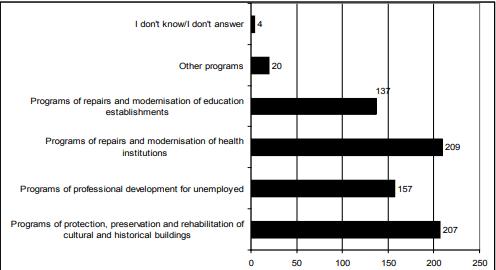
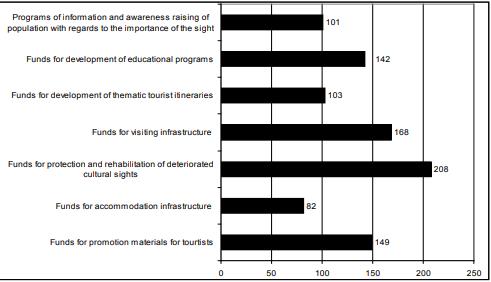
One may see that in approximately equal percentages (70%) the respondents have chosen programs
dedicated to repairs and modernisation of public health institutions, followed by the ones dedicated to
protection, preservation and rehabilitation of cultural and historic buildings (69%). However, it is
worth remarking that in România, a country with a relatively high unemployment rate (5.18% in
November 2014 (ANOFM),the percentageof respondents who considered that money should be also
assigned to protection and rehabilitation of cultural sights was nearly equal to the percentage of those
who want the money to be spent on professional development for unemployed. The profile of the
respondents who opted for assignment of money to use of heritage sights falls under the young age
group (high school graduates and college students), preponderantly in the urban areas. This part of the
respondents want the money to be spent on programs of information and awareness raising of
population with regards to the importance of the built cultural heritage.
In relation to the same issue (of funds assigned) most respondents wish that they were directed
towards deteriorated sights (208 responses), followed by funds assigned to the visiting infrastructure
and promotion for tourists (approx. 50% of responses), and those assigned for modernization of access
ways, construction of accommodation and restaurant locations, camping spaces, billboards and
information points, internet websites, brochures, maps etc.
Such responses may translate into the locals’ need to find out more information about the heritage
sights in their community and the risks of their total degradation or even loss. In addition, another
conclusion drawn from the responses given highlights the need to finance rather the activities to
educate the population with regards to protection of cultural sights and especially their use in tourism.
Furthermore, the participants to the study were asked to identify from a list given the public
institutions, organizations and persons that should be responsible for the maintenance and financing of
the heritage sights (question 11 in the questionnaire). Most respondents (75%) consider that the
responsibility should be the Ministry of Culture and local and county authorities (fig. 9), half of them
consider that the population living in such cities should also be responsible for the maintenance and
financing of such sights. A low percentage of respondents indicated other institutions such as the
European Union and various NGOs. From this point of view, one may see that the activity of these
institutions is generally less known by the participants to the survey, while the ones who stated the
existence of such institutions consider that their activity is opportune for the maintenance of the
heritage sights and that such activities of education, rehabilitation and maintenance of heritage sights
are necessary.
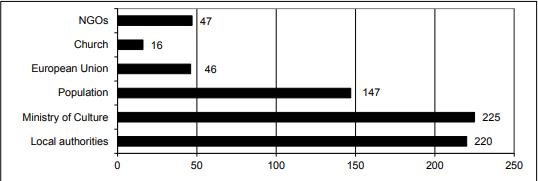
The last topic approached focused on the social responsibility and the civic involvementand
included two questions concerning the population’s involvement, by financial donations and
volunteerism activities (fig. 10).

The responses were directed towards volunteerism activities (90%), mainly in urban areas, and a
lower number of people would be willing to contribute by financial donations to the rehabilitation of a
heritage site located inside their residence areas (71%). The profile of the donors is generally young-
adult, of ages between 20 and 30 and middle-aged 30 to 40 year-old young people, who are better
informed, have a job or attended a high school or a university, mainly women.
4Conclusions
This study is meant to identify and explain the opinions, perceptions and attitudes of Dambovita
population in relation to build cultural heritage sights.
The starting hypothesis for the study was confirmed by the fact that the respondents of the sample
involved in this matter highlighted through their responses the importance of the cultural sights as well
as their protection and rehabilitation as they represent values of the local, regional and national identity.
Additionally, one may see that the respondents mainly want the protection of the built cultural
heritage, through the involvement of relating ministry and of local authorities, use of such sights mostly
for tourism as well as educating the population with a view to form civic responsibility and social
involvement in order to protect the cultural heritage. The population analysed appreciates primarily the
functionality, utility and recognition of such sights at community level, as well as the inhabitants’
devotion to them.
The results obtained and presented may become useful for the local tourism policies or the local
development strategies. Opinions and attitudes of respondents represent landmarks for the experts in
terms of usefulness of heritage sights and order of priorities on the local agenda.
Furthermore, the analysis of the results indicate that young people know these sights better, that the
number of visits made to these sights is higher among them, comparatively with older people, that
young people are more active in the process of collective financing, more socially responsible and
civically involved in activities of preservation and rehabilitation of heritage sights. Mass-media,
internet, interactivity on the current social networks, groups of friends are only a few elements
generating such information, transmitting and explaining a series of aspects relating to the issue under
discussion.
References
- ANOFM (National Agency for Workforce Occupation within the Ministry of Work, Family, Social Protection and Elderly, Statistical Records of Unemployment at the end of 2014) - http://www.anofm.ro.
- INCFC (2013). Sectoral Strategy in the Domain of Culture and National Heritage for 2014-2020. Bucharest. National Institute for Research and Cultural Training (2015). Cultural Consumer Barometer, Culture between Global and Local. Bucharest.
- Official Monitor of Romania, no. 152 of April 12, 2000, Law no. 5 regarding the National Land Development Plan - Section III – protected areas.
- Official Monitor of Romania, Part I, no. 573 of July 3 2006, Law no. 422/2001 regarding protection of historic monuments, as republished.
Copyright information

This work is licensed under a Creative Commons Attribution-NonCommercial-NoDerivatives 4.0 International License.
About this article
Publication Date
04 October 2016
Article Doi
eBook ISBN
978-1-80296-014-3
Publisher
Future Academy
Volume
15
Print ISBN (optional)
-
Edition Number
1st Edition
Pages
1-1115
Subjects
Communication, communication studies, social interaction, moral purpose of education, social purpose of education
Cite this article as:
Pehoiu, G., & Sencovici, M. (2016). Built Cultural Heritage. Perceptions, Attitudes and Opinions Met among the Population of Dâmbovita County (Romania). In A. Sandu, T. Ciulei, & A. Frunza (Eds.), Logos Universality Mentality Education Novelty, vol 15. European Proceedings of Social and Behavioural Sciences (pp. 710-719). Future Academy. https://doi.org/10.15405/epsbs.2016.09.90

